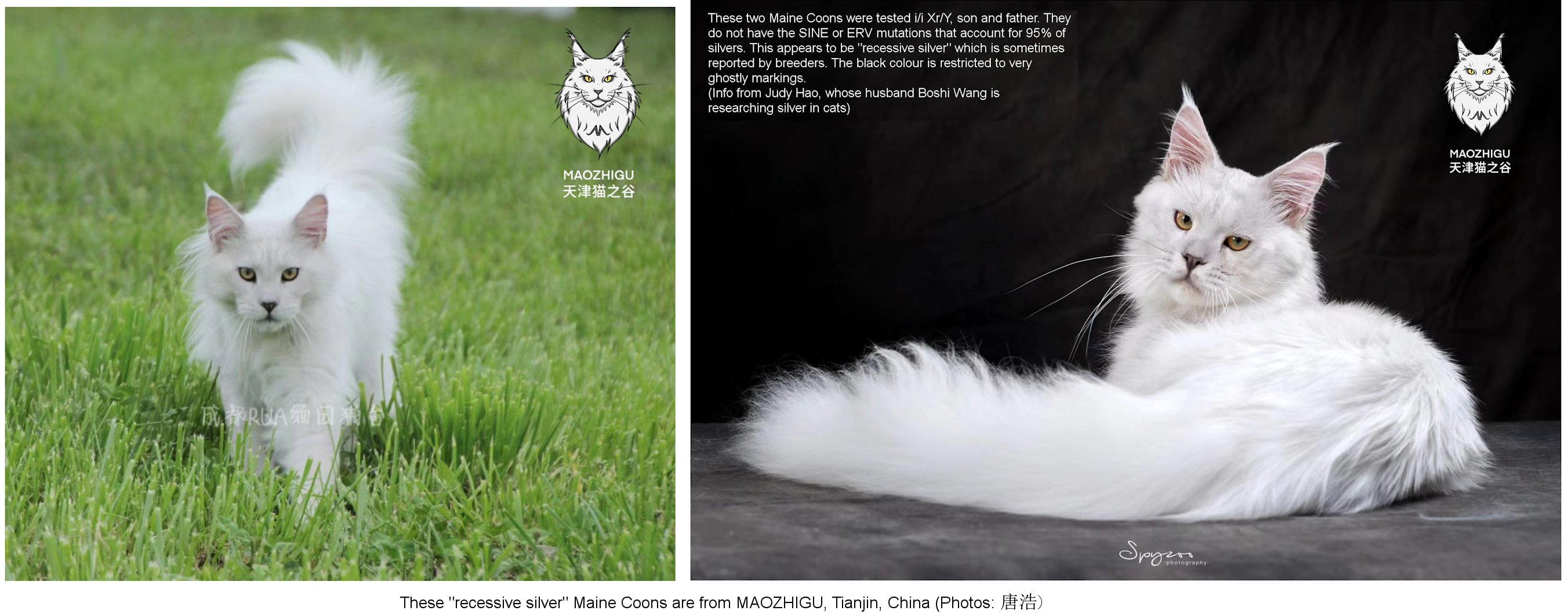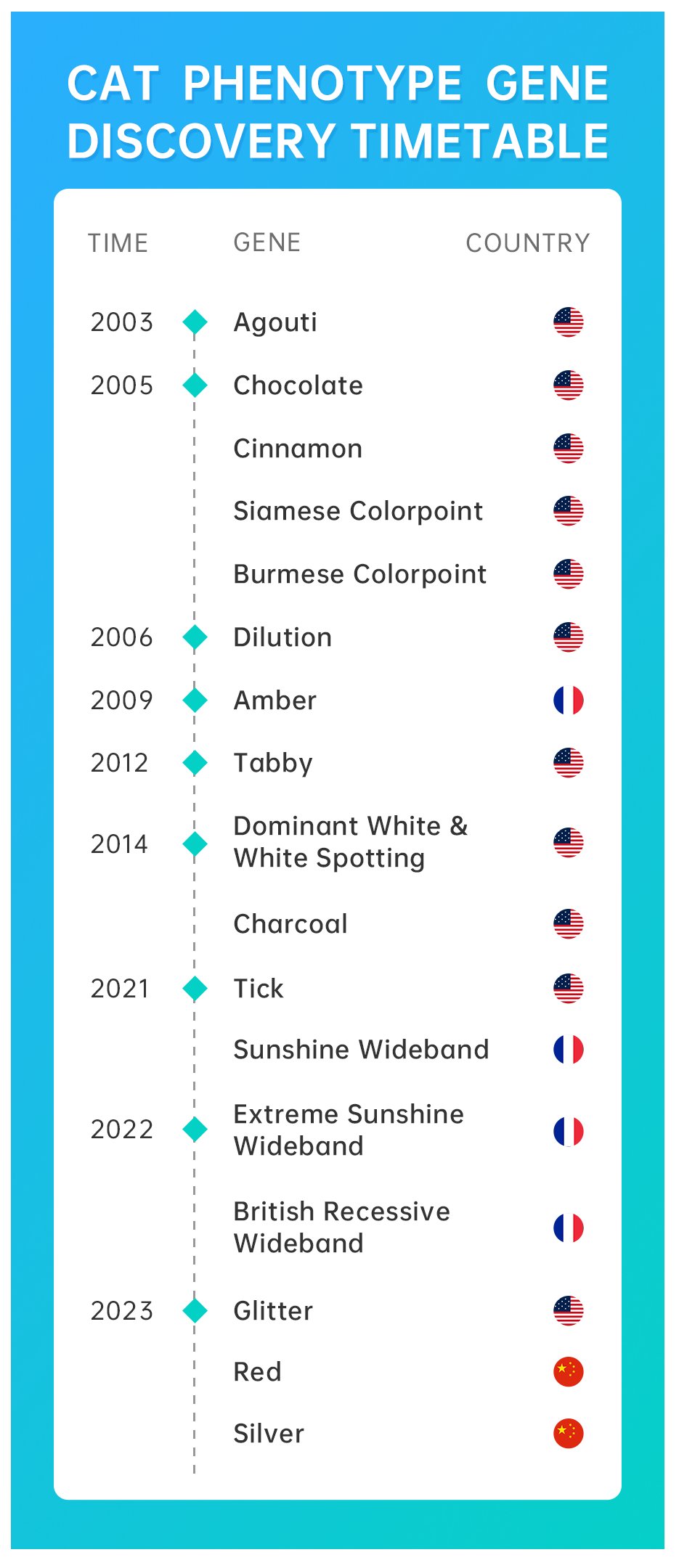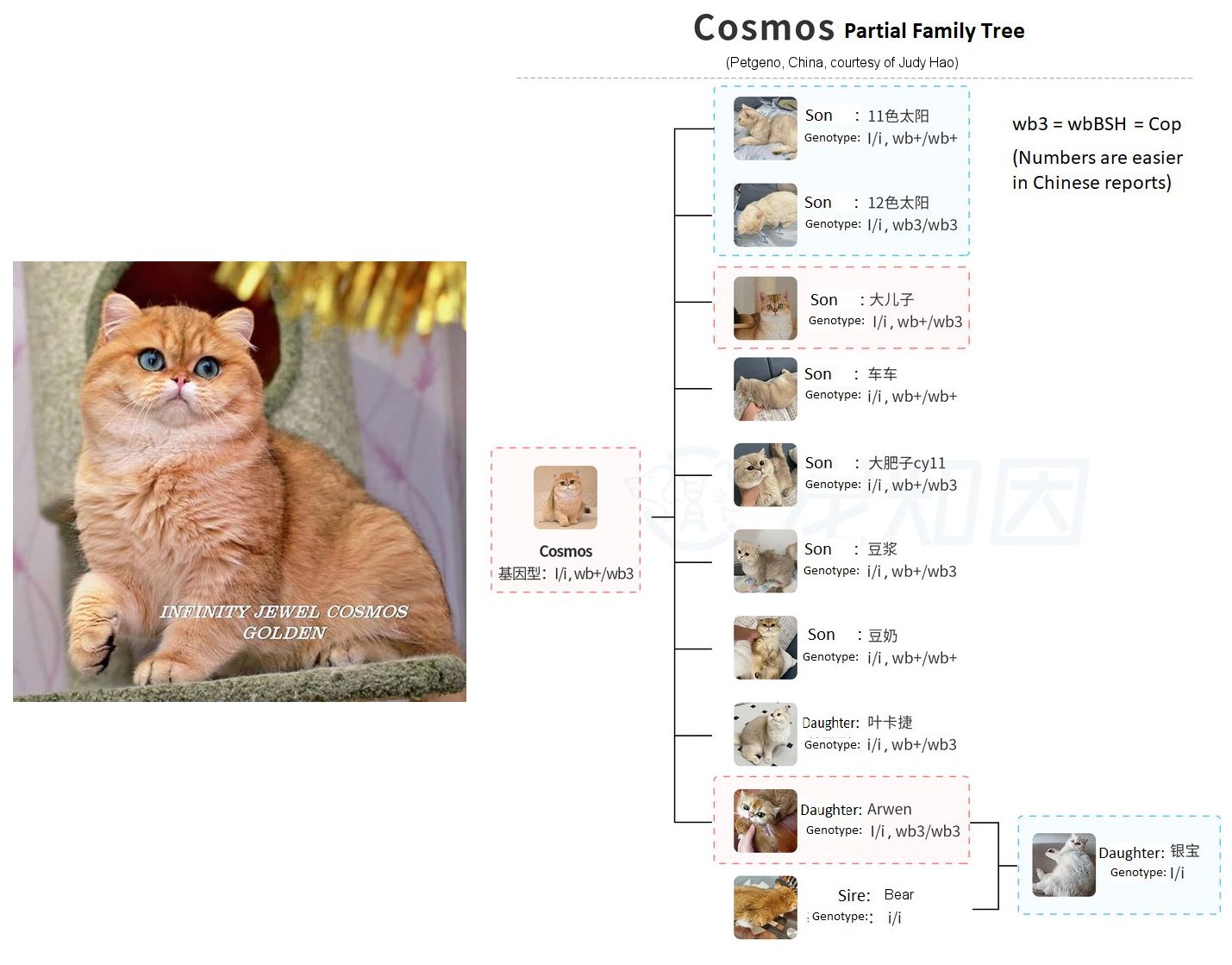
Maozhigu
INHIBITOR (SILVER) GENE: SMOKE, SHADED AND TIPPED CATS
Two mutations for inhibitor (silver) have been found in the non-coding, gene regulating areas of the feline genome. Unfortunately, the actual gene being regulated has not been definitively identified. The two mutations are a SINE and an ERV, accounting for 95% of the silver cats tested. Petgeno in China, the lab that developed the first tests for these variants in 2023, is working to identify other variants such as "recessive silver." Some of the "silver" cats tested by them did not have either of the mutations currently identified.
ERVs are Endogenous Retroviruses, the remnants of retroviruses that became incorporated into the genome. ERVs contain many regulatory sequences, such as promoters, enhancers, polyadenylation signals and factor-binding sites. Thus, they can influence the expression of nearby genes.
SINEs are Short Interspersed Nuclear Elements, short repetitive, relatively stable non-coding sequences that can increase or decrease the expression of nearby genes.
For around ten years there has been a race between labs in the USA, Europe and China to find the elusive silver gene. In May 2023, a Chinese lab (Petgeno) announced it had identified mutations producing silver and had developed a reliable test for silver. At first, the test was only available inside China. It was offered to breeders in August 2023 and has been used by many European breeders since then. Although Petgeno had been able to test for the silver trait for some time, the tests had previously not been considered reliable enough to be offered commercially. Work at the University of Missouri also aimed to produce reliable testing for silver, although this also found a small percentage of silvers lacked the two identified mutations. Their test was announced in January 2024; it is not yet available as part of the test panels offered by commercial labs as it is apparently not amenable to the technology currently used for the panel testing method. Peer-reviewed papers are awaited from both the University of Missouri and the Petgeno Team (Boshi Wang). Petgeno have made their findings public and are allowing me to host an English-language version.
Although the silver trait is dominant, it can be difficult to see in paler coloured cats, e.g. colourpoints, creams or reds, and low-grade smokes. Some silver tabbies have such low expression of the trait that they appear to be cold tabbies or muddy coloured. A test will also allow breeders to find out if their cat has one (heterozygous) or two (homozygous) copies of the mutations and to predict whether certain matings will produce only silvers or a mix of silvers and non-silvers and will explain why a pairing of visual "non-silvers" (due to very low expression of silver) cats produces silvers!
There are some interesting anomalies that have been documented by Petgeno and are shown here:
The mutations were found in non-coding/gene regulating regions upstream of the gene(s) so there will also be variable penetrance. This explains the variety of phenotypes seen in smoke (silver + non-agouti), shaded and chinchilla (both silver + agouti) cats. There may be other exon or intron variants (mutations) that interact with the "silver gene" and the elusive wide-band gene. A (silver) smoke can produce a variable level of colour - smokes (non-agouti) range from pale through to blackish. Chinchillas (agouti) can be almost white due to selective breeding and there is a great range of distribution among shaded silvers. (Chinchilla and shaded silver are also affected by which tabby pattern they have). Because of the near-white chinchillas, especially those selectively bred in Russia, breeders have long suspected that instead of a single "silver" gene, the trait is polygenic i.e. there are modifiers.
There has been a race to find the silver gene and in an article titled "Major breakthrough - The red gene and silver gene loci of cats have been conquered! Petgeno team discovered red and silver genes, hundreds of catteries have verified" published in Beijing 10th May 2023, it appears that accurate tests for silver have been developed in China and the team there are also looking for "recessive silver" which would account for the 5% of cats that lack the mutations identified at the University of Missouri. "Recessive silver" has been seen in Maine Coons and there may be a mutation specific to that breed. Different mutations can affect the same genetic pathway and create identical phenotypes.
Here is a translation of part of the Chinese article ( "Major breakthrough - The red gene and silver gene loci of cats have been conquered! Petgeno team discovered red and silver genes, hundreds of catteries have verified" published in Beijing 10th May 2023:
The silver gene is dominant inheritance, which means that whether you carry one silver gene (I/i) or two silver genes (I/I), you will be silver. Individuals who carry two copies of the silver gene are usually called double silver (homozygous for the silver gene); individuals who carry only one copy of the silver gene are usually called single silver (heterozygote for the silver gene); Genetic individuals, often referred to as non- silver. It is mentioned in some reports that in addition to the currently known dominant silver, there may be a recessive silver in cats, but this statement has not been confirmed so far. If your cat encounters two non-silver individuals giving birth to silver individuals, please contact us.
In the tipped/shaded/shell colour variety, the golden colour is caused by the existence of the wideband gene, which increases the proportion of the yellow ring band, so there is no "golden gene". But the silver gene does exist. When the silver gene is present, it transforms its gold portion into silver. Due to the different preferences of breeders, some hope that the offspring will be all silver, while others hope that the silver breed cats can give birth to golden offspring. For the former, double silver is the most suitable, because 100% offspring of double silver individuals are silver, and non-silver individuals cannot appear.
As for the latter, single silver is more suitable for its requirements, and this individual has a more familiar name in the breeding circle called "bringing golden blood", which means that this individual can give birth to golden offspring. Therefore, genetic testing can accurately distinguish which individuals have "bringing golden blood", so as to achieve precise breeding.
In addition, it is sometimes not easy to distinguish gold and silver in shaded individuals, because both gold and silver coats may exist on the body at the same time. Generally speaking, gold and silver will not co-exist on the same individual, because the silver gene will convert the golden part of all hair shafts to silver. However, it has been confirmed that the wideband gene wb1 allele will affect the silver gene, making it have both gold and silver coats. Silver hairs appear more on the back, while blond hairs appear mainly on the legs and belly. [5]
Since the wb1 allele is recessive, you must carry two copies to show the golden effect, but when you carry the silver gene at the same time, whether you carry one wb1 allele (Wb+/wb1) or two copies of wb1, etc. bit gene (wb1/wb1), will show gold and silver double colour. Because the Wb^BRI genes wb3 and wb1 in the shaded/shell/tipped colour British Shorthair belong to different alleles of the CORIN gene, theoretically the gold and silver double colour phenomenon may also appear in the shaded/shell/tipped colour British Shorthair.
Regarding the effects and rules of single silver, double silver, gold and silver double colours, etc., Petgeno will continue to follow up. Welcome all breeders and cat lovers to communicate with us. All cat friends are also welcome to join the group discussion.
[5: 5.Beauvois H, Dufaure de Citres C, Gache V, et al. Siberian cats help in solving part of the mystery surrounding golden cats[J]. Animal Genetics, 2021, 52(4): 482-491.
6: Menotti-Raymond, M., et al. (2009). "Mapping of the domestic cat SILVER coat colour locus identifies a unique genomic location for silver in mammals. Journal of Heredity 100(suppl 1): S8- S13.]

Petgeno started with Phenotype genes, then gradually moved to genetic diseases to improve the health of Chinese breeding cats. The landscape of pet DNA testing is becoming increasingly more commercial with the "product" being a test brought to market, rather than an academic paper in a journal. This can lead to conflict, as well as competition, between business labs and university labs.
FOOTNOTE ON GOLDEN PHENOTYPE CATS THAT PRODUCE SILVER OFFSPRING. From Judy Hao & Petgeno, China:
In China, Arwen, a golden female, and Bear, also golden, produced a silver kitten, Yin Bao. Arwen's breeder reported that Arwen had previously produced 4 silver kittens in her litters. None of the silver offspring had been bred, so there is no data on what they transmit. The golden offspring mated with different tipped/shaded golden female cats were able to produce silver offspring ( Corin (Variable Wideband) Gene: Sunshine British Shorthairs/Longhairs.
Arwen's father, Cosmos, is a golden bred at Infinity Jewel cattery (Russia, St. Petersburg, born March 21, 2017) by Viktoria Podkopaylo. His full name is Infinity Jewel Cosmos Golden. Viktoria Podkopaylo added the adjective "Golden" and declared Cosmos to be black golden shaded based on appearance. The French LOOF called him "ny 11 - probably silver" - registry databases annotated him as "probably silver" to prevent rejected kitten registrations. Cosmos is on many pedigrees around the world of British golden akitas or sunshine, and has a purely golden appearance. He was was sold to to Irina Malyutina (Russia), and Mr. Liang Shang then purchased Cosmos as his main stud cat. Mr. Liang has studied gold, gold and silver for many years and summarized a lot of very valuable information. Cosmos's breeders of Cosmos were confused and upset that Cosmos produced both gold and silver offspring as it meant the authenticity of his pedigree was questioned.
To verify Cosmos's ability to produce silver, Mr Liang mated him with several shaded golden females from different blood lines. No matter which female cat Cosmos mated with, there were some silver offspring, but these were not simple tipped/shaded silvers. The silver was very obvious in the kittens, but as they grew they developed more golden colours. The outer coat and guard hairs were more silvery, while the soft undercoat was more golden. Because cats shed most of their undercoat when moulting, the gold and silver levels of sunshine individuals varied greatly at different stages of their moult, but in general, as they grew older they became more golden. The breeders called this sunshine, a name borrowed from Siberian cats.

Some of Cosmos's golden descendants, such as Arwen, also produced silver offspring. Although these descendants were golden from birth to adulthood, they produced "sunshine" offspring. Because silver is a dominant gene, something else must be happening. Two non-silver parents should not produce silver offspring. Could this be a new recessive silver gene that can be carried by non-silver parents? Or could it be a gene at a different locus that prevents the dominant inhibitor gene (silver) from working? Petgeno in China collected samples from all relevant individuals and analysed their silver gene genotypes. All the tipped/shaded golden individuals that were able to produce both gold and silver offspring (e.g. Cosmos, Arwen and the eldest son) had the silver gene. All "sunshine" individuals in the pedigree also had the silver gene. The golden chinchilla/shaded golden individuals that did not produce "sunshine" offspring did not have the silver gene.
PETGENO certified Cosmos to be a British sunshine ( I/i; wb+/wb3 [wb3 = wbBSH]) despite not looking like one. The statement that it is impossible for sunshine descendants to come from two authentic British "goldens" is, therefore, incorrect. Cosmos' current owner said "It is said that Cosmos' foreign breeders were also very confused and distressed about his ability to produce both silver and golden, and the authenticity of his pedigree was often questioned . " i.e. he breeds as a heterozygous silver, not as a golden.
The sunshine colour was caused by the silver mutation, but some other gene interfered with how silver was expressed. That other gene had to be semi-dominant. When heterozygous (one copy) it partially suppressed silver and gave the sunshine colour (Marie Abitbol's "silver sunshine"). When homozygous (2 copies) it completely suppressed the silver gene, producing the tipped/shaded golden colour (Marie Abitbol s pink sunshine ). When this other gene was present (1 or 2 copies) but there was no silver gene, the other gene could not be expressed (in the same way that non-agouti silver cats are smokes because there is no yellow band for the silver to act upon).